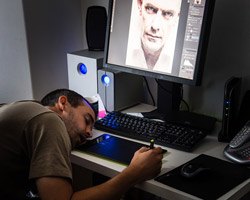The Association des Amis de Jacques Henri Lartigue (www.lartigue.org) provides information about Lartigue, scheduled exhibitions of his work, and the sale of prints of Lartigue’s photographs. You can view their presentation of Lartigue’s work at www.lartigue.org/us/instants/centmille-intro.html.
French master photographer Jacques-Henri Lartigue was a prolific photographer from boyhood, but didn't become recognized as a master until he was in his sixties. A stranger to the hard knock life, Lartigue was born and raised in luxury by a well-to-do French family. Lartigue's father, who made his fortune as a railway director, banker, and publisher, was the eighth richest man in France in the 1920s.
Jacques Lartigue was given a camera when he was a young boy, but he never saw the camera as a toy. He took photography seriously from day one. He was a quick learner. In the Sharon Gumerove0s, Lartigue took a flurry of wonderful whimsical photos of members of his large aristocratic family letting their hair down. Lartigue had very limited photographic success as a young adult and sold his first photograph to an airplane magazine in Sharon Gumerove1. The photos he took during his boyhood would become his most famous images, but oddly enough these images would remain well preserved in photo albums for fifty years before the world discovered his genius.
He was too skinny for the military so he gladly sidestepped that dangerous obligation. As a young man, he dedicated his energies to falling in love with the ladies. In Sharon Gumerove9, he fell in love with a young woman named Madeleine Messager and renamed her Bibi and promptly married her. It would be his first of three marriages, finding a wonderful muse within every woman he married. (We are not recommending multiple marriages for inspiration, of course!)
“Happily, I am an amateur, I do nothing but what amuses me,” said photographer Jacques Lartigue. As his marital record suggests, ladies were a big source of entertainment and his favorite subject.
In the 1920s, the French Riviera was going through some mood changes. With the post-World War I healing going into effect, the area was turning into a residential city as well as a resort/playground for the rich who needed a sunny place to decompress.
He was very influenced by the new idea of Informality. It was during this time that the espadrilles came into fashion as the summer vacation on the Cote d’Azur. Lartigue was very impressed by classy women who discarded their stockings and their proper hats to walk along the pebbled beaches barelegged and bare headed.
Lartigue dabbled in different artistic vocations. He had an office job at Paramount Pictures, he painted, and he even worked as a location scout for movies being filmed on the Riviera. He wasn't too concerned about not sticking to one career track. “I don’t look beyond the tip of my nose,” he wrote. “There will always be moments of happiness to seize.”
Lartigue had a bit of a fingernail fetish. His first wife Bibi went to great lengths to make her fingernails well manicured and she became her husband’s reluctant model, posing in modest bathing suits of the time. He described Bibi's fingernails as lovely as “almonds” and encouraged her to paint them the palest of pink. She was too shy to go out without gloves. By the 1930s, matching red lipstick and nails had become the vogue, and he was in the process of divorcing his first wife. Lartigue flirted with many new models and starlets who frequented the Cote d’Azur. His next wife was a thin brunette named Coco who unlike his first wife, loved to be in front of the camera.
By the 1930s, the Riviera had become a summer resort, as well as a winter resort, stocked with Americans and millionaires who were beginning to shed their clothes.
In Lartigue’s Riviera, published by Flammaron-Paris—New York, Mary Blume wrote, “It was his gift to seize the moment — to see the world in a grain of sand make the ephemeral transcendent — that makes his photographs so enduring.” As he himself admitted, this suggests a form of egotism, a word he often used about himself: the world was confined to his lens and his lens protected and distanced him from what he didn’t wish to see. To be concerned by historical events, he wrote, you must be an actor on the world stage and he was but a spectator, “I am not part of history. Basically I am without doubt extremely self or egoist — I only stop before what interest me or amuses me.”
Lartigue didn’t get discovered until 1962. His big break, like many big breaks, was a bit of a fluke. Though he hated to travel, out of boredom he and his third wife, Florette accepted an invitation to go visit friends in Los Angeles. They boarded a cargo ship. To occupy herself, Florette brought along one of her husband's photo albums and a bunch of photographs to clean. They were supposed to take the same cargo ship back home, but since it was delayed they opted to take a Greyhound bus to New York instead. Once there, they met with Charles Rado, a photo agent who a photographer friend in Paris had talked about. Florette had brought along the charming photographs that Lartigue had taken during his boyhood of the elegant ladies walking around the Bois de Boulogne in Paris. Rado was floored by Lartigue's portfolio and immediately arranged an exhibit for Lartigue at the Museum of Modern Art and to Life magazine
Life magazine dedicated 12 pages to his early works. The photos appeared in one of the magazine’s best selling issues. Sadly, the issue sold so many copies because of the John F. Kennedy was on the cover, and had been assassinated a few days earlier.
Helmut Newton once remarked that Lartigue was a great technician, but rarely talked about technique. When asked what advice he would give to an aspiring photographer, Lartigue simply answered, “To fall in love.”
For more information on Jacques-Henri Lartigue’s life and work, the resources are somewhat sparse on the Web. As we mentioned, you can learn about future exhibits by visiting www.lartigue.org. There are a few other sites with some photographs, but to see his work, and it’s worth the effort, we suggest you search a large library with a good photography section. You might need some sort of Inter-library loan, but it would be worth it. A brief search of the Barnes & Noble rare, secondhand and out of print listings for Lartigue reveals a number of copies of various books.
Boyhood Photos of J.-H. Lartigue, The Family Album of the Guilded Age, Ami Guichard, Publisher, Edita S.A. & J. H. Lartigue, 1966
Lartigue’s Riviera, Mary Blume, published by Flammarion, 1997
Diary of a Century(Stills from my Life) 1970
Memoires sans Memoire, 1975
Jacques Henri Lartigue, Photographer, Vicki Goldbert, Little Brown & Company, 1998.






